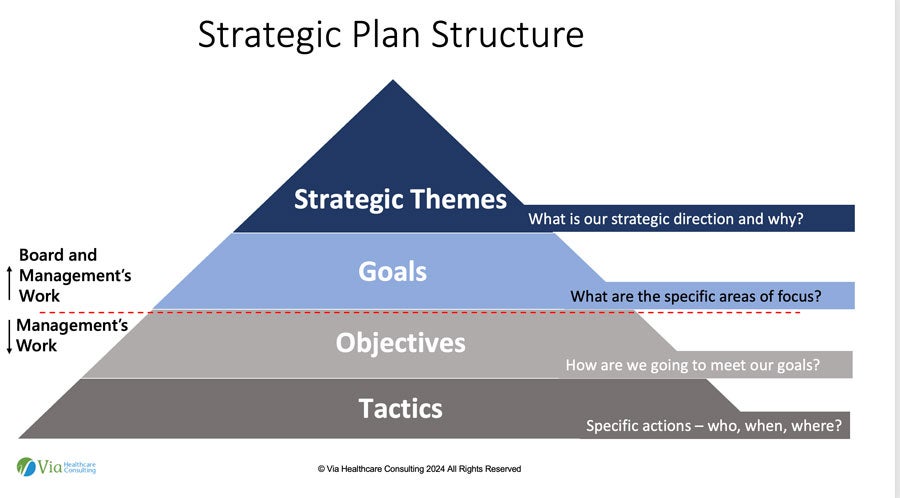
Mission/Vision/Strategy
Planning for the Day after Tomorrow
Board-led strategic planning provides an organizational roadmap
By Linda Summers
Perhaps due to the “new normal” created by COVID-19 or the financial challenges creating an ongoing threat, health care organizations across the country are currently undertaking new strategic planning efforts in droves.
Simply put, strategic planning is a set of specific steps that, when followed, are designed to identify themes, develop goals, and create a roadmap of how to achieve those goals. A well-structured strategic plan can serve as a decision-making tool for the organization to use in staying focused on its highest priorities. Done well, strategic planning supports the organization’s efforts to stay true to its mission, avoid overreaction to smaller challenges and provide focus on the most important work at hand.
It all begins with planning for the day after tomorrow.
The Board’s Work
At the core of the board’s fiduciary duties is the need to think strategically about where the organization needs to go, how it should best serve its mission and to the priorities on which it should focus. The process of strategic planning should not be delegated solely to management. Although management’s involvement is critical, the responsibility to set the strategic direction ultimately belongs with the board.
One way to picture how board-led strategic planning works is shown in Figure 1 (see next page). At the top of the pyramid lie the strategic themes. These include concepts or ideals that the board believes are critical to the mission and success of the organization. Themes might include improving access to care, expanding community partnerships or perhaps “growing our own” to address workforce challenges. The themes should set a high-level strategic direction that will guide the organization’s work for the next 3-5 years, while keeping an eye on the longer-term aspirational vision of what the organization would like to become. Setting the strategic themes is clearly a board- and management-partnered responsibility.
Figure 1. Strategic Plan Structure

The goals are more specific steps that will prioritize the work that is to be completed under each of the themes. The goals should be developed by the management team but ultimately decided by the board. Both the themes and the goals serve as the “what” of the strategic plan: “What are we going to do to drive the work needed to support the organizational strategic themes?” These first two areas are the primary responsibility of the board.
The objectives and tactics are the “how” in achieving the goals established. This is management’s work. They are the organization’s experts on the tactical and operational steps needed to achieve the goals. While it may be tempting for board members to jump into the “how,” it is generally not in the organization’s best interest. Although management may ask for board input on some of the specific tasks, deep involvement in this work by the board can be problematic. First, it distracts the board from staying at the strategic level needed to keep an eye on the long-term horizon. Secondly, it blurs the lines of governance and management, which can create problems down the road. Third, it may convey a lack of trust and confidence in the management team — a necessary ingredient for long-term success.
Keeping clear lines of responsibility will serve to support both optimal governance and management and allow the organization its best opportunity for success.
A Road Map for Planning
Below are a set of steps that provide a road map of the process, while keeping everyone functioning at just the right level.
Affirm the organization’s mission and vision. The early stages of strategic planning can serve as the perfect time to revisit, and either affirm or revise, the mission and vision. The board is responsible for ensuring that the current mission is truly what is best for the organization and the communities that it serves. Boards should consider whether the current mission, vision and values continue to resonate with the employees, the providers, the patients, and the community as the compelling reason why the organization exists and what it is trying to accomplish.
Consider a strategic planning steering committee. A steering committee allows the organization to identify a core group of individuals that will guide the strategic planning process. A smaller group, fewer than 8-10 people, is generally most effective. Most often the steering committee is comprised of both executives and board members. Their purpose is to ensure the planning process moves forward on the identified timeline, following the predetermined steps.
Perform a strategic assessment. The first step in the process is to determine the current state of the organization. It is impossible to know where you need to go if you don’t know where you are today. This involves a strategic assessment across all areas of operational performance, as well as an external environmental scan. What data or information can be used to identify the areas of greatest need? How can we address the glaring health inequities brought to our attention during the pandemic? What data can we use to ensure the priorities determined are the right ones?
The strategic assessment includes both a quantitative and qualitative component. We advocate taking a balanced approach across all areas: quality, service, people, finance, growth, and community. This will ensure a plan is developed that addresses the areas of greatest need while considering the entire operational picture.
Some organizations may struggle with the data analysis, dealing with disparate systems and, at times, a lack of strong data and decision support. However, don’t let perfect be the enemy of good enough. Work with the data your organization has and support what management is able to provide. The management team will recognize and be able to deal with data that seems to be providing an inconsistent story.
The qualitative assessment can be even more revealing to the areas of opportunity. This involves seeking information on the organization’s strengths, weaknesses, opportunities and threats from a broad base of stakeholders. This would, of course, include the board members. We suggest individual interviews with each board member to ensure that all voices are heard. Other key stakeholders are providers, executive and middle management leaders, employees, community partners, public health entities, etc. This process can be achieved through written or verbal surveys, focus groups or interviews.
The external environmental scan involves looking at the communities and area in which the services are provided. This can provide information to the board and management team about trends such as population health, health inequities and chronic disease. The external environmental scan also provides an opportunity for the organization to consider demographic data such as population aging, income, education levels, etc. This broadened understanding of the environment can lend insight into future planning for certain services or needs. It can also provide access to opportunities the organization and board did not know were available or possible.
Identify strategic themes. Following the completion of the strategic assessment, the board should meet to discuss its findings. This is a wonderful opportunity for management team members to showcase their understanding of both the internal and external environment, building trust and confidence among all members. As the team presents the assessment, opportunity themes will undoubtedly arise. Those themes can run across some or many of the areas of operations. We recommend no more than five strategic themes. This can be difficult for boards and executives as there is always so much to be done. Keep the priorities well-defined. When everything is important, nothing is.
Establish goals. After the board has established the strategic themes, the management team then goes to work establishing a short list of goals for the board to consider under each theme. Again, the list should be no more than 4-5 goals per strategic theme to ensure the prioritization of the work. The final step in the goal setting process is to circle back to the board for review, revision, and final approval of the goals. Management now must take those goals and translate them into objectives and tactics.
Define objectives and tactics. As outlined earlier, objectives and tactics are the “how.” This is the work of management. These objectives should be SMART: Specific, Measurable, Achievable, Realistic, and Timely (or time driven). The SMART objectives will allow the board to track progress and hold the management team responsible for the specific work to be completed. The tactics should also identify who will be responsible, when specific tasks will occur and what information will be gathered to meet the objectives.
Draft the final plan for board approval. The final step in the planning process is the presentation to the board of the final draft of the strategic plan. This is where it all comes together. The board may make final adjustments or revisions, but if communication has been consistent throughout the process, the plan should be essentially complete. This is a great time to celebrate the hard work that has been completed.
Create the final strategic plan and close the feedback loop. There is still a bit of work to be done by the board and management team. The final strategic plan should be presented to the full board and approved as the organization’s focus and priority for the determined period of time. Another key final step is ensuring there is an effective process to communicate the strategic plan to the key stakeholders. This is critically important for buy-in.
Key concepts to keep in mind. Remember that the plan should be dynamic and fluid. Discuss it regularly at board meetings. Revise the plan if the key drivers of the organization’s direction change or imperatives shift. It is better to adjust in real time than remain bound to a plan that may no longer provide what is needed. Discussing the plan often at the board level will ensure accountability: both for the board to remain focused and the management team to execute the established plan.
Secret of Success
One secret to successful strategic planning is to remember that the process of how an organization arrives at the strategic plan can be as important as the content of the plan itself. Sometimes, a strategic plan that looks brilliant on paper does nothing more than collect dust on bookshelves, while a strategic plan that is simple enough to fit on a single page forms the roadmap for complete organizational transformation. Ensuring the ownership and buy-in of the stakeholders who are needed for the successful implementation of the plan — the leaders, staff, providers and community — is the key to effective strategic planning that results in real change.
Finally, undertaking a strategic planning process doesn’t need to be onerous. Consider taking specific, concrete steps and identify responsibility and accountability up front. Stay true to the mission, remain at the governance level, be realistic and be flexible. The plan does not need to be complex or perfectly organized. The important element is to create a plan that will yield results. It is sometimes the most straightforward approach that achieves the best results. Keep it simple, fluid, dynamic — and most importantly — front and center to the organization’s direction.
Linda Summers, FACHE, MBA (lsummers@viahcc.com), is a senior principal at Via Healthcare Consulting, based in Carlsbad, Calif.
Please note that the views of authors do not always reflect the views of AHA.
